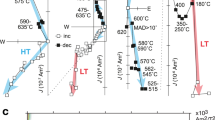Abstract
Theoretical predictions of non-synchronous rotation and of polar wander on Europa have been tested by comparing tectonic features observed in Voyager and Galileo spacecraft images with tidal stresses. Evidence for non-synchronous rotation comes from studying changes in global scale lineaments formed over time, from the character of strike-slip faults, and from comparison of distinctively shaped cycloidal cracks with the longitudes at which such shapes should have formed, in theory. The study of cycloids constrains the rotation period (relative to the direction of Jupiter) to less than 250 000 years, while direct comparison of the orientation of Europa in Voyager and Galileo images shows the rotation is slow, with a period of >12 000 years. Comparison of strike-slip faults with their theoretical locations of formation provides evidence for substantial polar wander, supported by the distribution of various thermally produced features.
Similar content being viewed by others
References
Figueredo, P. H. and Greeley, R.: 2000, 'Geologic mapping of the northern leading hemisphere of Europa', J. Geophys. Res. Planets 105, 22629-22646.
Geissler, P. et al.: 1998a, 'Evidence for non-synchronous rotation of Europa', Nature 391, 368-370
Geissler, P. et al.: 1998b, 'Evolution of lineaments on Europa: Clues from Galileo multispectral imaging observations', Icarus 135, 107-126.
Geissler, P. et al.: 1999, 'Rotation of lineaments in Europa's southern hemisphere', Lunar Planet. Sci. XXX, Abstract #1743.
Goldreich, P.: 1966, 'Final spin states of planets and satellites', Astron. J. 71, 1-7.
Greenberg, R. and Weidenschilling, S. J.: 1984, 'How fast do Galilean satellites spin? Icarus 58, 186-196.
Greenberg, R. et al.: 1998, 'Tectonic processes on Europa: tidal stresses, mechanical response, and visible features', Icarus 135, 64-78.
Greenberg, R. et al.: 1999, 'Chaos on Europa', Icarus 141, 263-286.
Greenberg, R. et al.: 2000, 'Habitability of Europa's crust', J. Geophys. Res. Planets 105(E7), 17551-17561.
Greenberg, R. et al.: 2001, 'Pits and uplifts on Europa: distributions and characteristics', Bull. Amer. Astron. Soc. 33, 1099.
Helfenstein, P. and Parmentier, E. M.: 1983, 'Patterns of fracture and tidal stresses on Europa', Icarus 53, 415-430.
Helfenstein, P. and Parmentier, E. M.: 1985, 'Patterns of fracture and tidal stresses due to nonsynchronous rotation: implications for fracturing on Europa, Icarus 61, 175-184.
Hoppa, G. V. and Tufts, B. R.: 1999, 'Formation of cycloidal features on Europa', Lunar Planet. Sci. Conf. XXX, Abstract.
Hoppa, G. V. et al.: 1999a, 'Rotation of Europa: constraints from terminator and limb positions', Icarus 137, 341-347.
Hoppa, G. V. et al.: 1999b, 'Strike-slip faults on Europa: global shear patterns driven by tidal stress', Icarus 141, 287-298.
Hoppa, G. V. et al.: 1999c, 'Formation of cycloidal features on Europa', Science 285, 1899-1902.
Hoppa, G. V. et al.: 2001, 'Europa's rate of rotation derived from the tectonic sequence in the Astypalaea region', Icarus 153, 208-213.
Leith, A. T. and McKinnon, W. B.: 1996, 'Is there evidence for polar wander on Europa'? Icarus 120, 387.
McEwen, A. S.: 1986, 'Tidal reorientation and the fracturing of Jupiter's moon Europa', Nature 321, 49-51.
Ojakangas, G. W. and Stevenson, D. J.: 1989, 'Polar wander of an ice shell on Europa', Icarus 81, 242-270.
Peale, S. J. and Gold, T.: 1965, 'Rotation of the planet Mercury', Nature 206, 1240-1241.
Riley, J. et al.: 2000, Distribution of chaos on Europa', J. Geophys. Res. Planets 105(E9): 22599-22615.
Sarid, A. et al.: 2001, 'Polar wander and surface convergence on Europa', Bull. Amer. Astron. Soc. 33, 1100.
Spaun, N. A. et al.: 2001, 'Characteristics of the trailing equatorial quadrant of Europa from Galileo imaging data', Lunar Planet. Sci. XXXII, Abstract #1228.
Tufts, B. R.: 1988, 'Lithospheric displacement features on Europa and their interpretation', PhD Thesis, University of Arizona, Geology PhD.
Zahnle, K. L. et al.: 1998, 'Cratering rates on the Galilean satellites', Icarus 136, 202-222.




